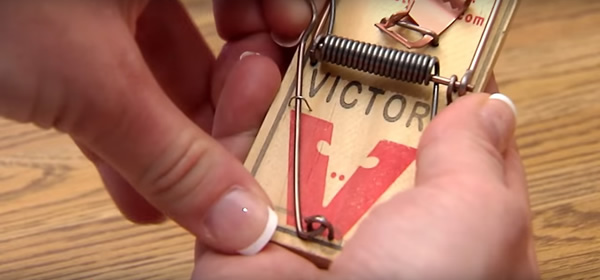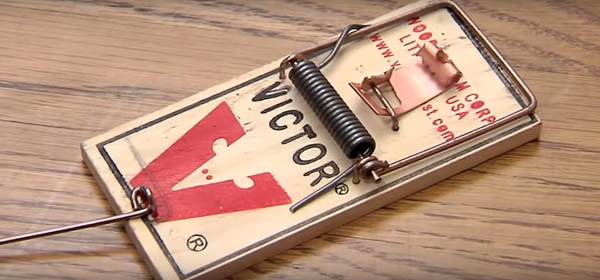Mice look fuzzy and adorable but, they are full of diseases. The rodents spreads diseases like listeria, salmonellosis, and hantavirus through urine, saliva, droppings, and nesting materials. Such diseases are deadly and you stand a risk of catching it if you have a mice infestation. Asides spreading disease, they damage home appliances and furniture. That is why it is so important to take all possible measures as soon as you see the first signs of mice infestation.

Most fresh droppings are moist and dark and as they age, they begin to dry out and become gray and old. These droppings crumble easily if touched. The best place to check for droppings is cupboards and drawers, under sinks, and other hidden areas. When you see large deposits of droppings, it means nesting or feeding areas are nearby. You can inspect the areas to determine the level of infestation or activity of the rodents.
Aside from droppings in hidden areas, you can expect to see gnaw marks if you have an infestation of mice. Unlike droppings, gnaw marks are lighter especially if they are newer. As they age, they become a lot darker. You can check food packaging for these marks as well as the structure of the house. Those are two areas you will likely find the marks. You may also need to determine how long they have infested the area by checking the marks. New marks are lighter and could indicate a continuing infestation. Such marks may also determine if you have mice or rats. Rats are responsible for larger marks since they have bigger teeth. However, it is still possible to graduate from mouse infestation to rat infestation.
Dogs and cats as well as pet rats or mouse can become excited and active if they come in contact with areas where rodents are present. Most times, this is a result of a foul odor that rodents produce. It often occurs when rodents enter a house newly. If you spot your pet pawing in an area where it hasn’t shown interest before then get a flashlight and inspect the place for mice.
It is easier to know if the infestation is large from the odor. You can also tell that the infestation is active by the ongoing stale smell.
When rodents are active in the house, they leave a distinctive track or runway. However, these tracks may begin to get fainter as time passes. Runways or tracks are easily detected with blacklight or flashlight held at the suspected area’s angle. Look out for:
Rodents often use different materials like fabric, shredded paper, or dried plant matter to build their nests. Check the area for the presence of:

What Are the Signs of Mice Infestation?
There are a lot of signs that indicate mice infestation. For instance, if the rodents are never seen during the day but seen at night then it means the population is not too large and using baits and traps can come in handy here. However, if you see rodents during the day, then you may have a serious infestation problem. Here are some other signs to look out for:Rodent Droppings
Most fresh droppings are moist and dark and as they age, they begin to dry out and become gray and old. These droppings crumble easily if touched. The best place to check for droppings is cupboards and drawers, under sinks, and other hidden areas. When you see large deposits of droppings, it means nesting or feeding areas are nearby. You can inspect the areas to determine the level of infestation or activity of the rodents.
Check for Gnaw Marks
Aside from droppings in hidden areas, you can expect to see gnaw marks if you have an infestation of mice. Unlike droppings, gnaw marks are lighter especially if they are newer. As they age, they become a lot darker. You can check food packaging for these marks as well as the structure of the house. Those are two areas you will likely find the marks. You may also need to determine how long they have infested the area by checking the marks. New marks are lighter and could indicate a continuing infestation. Such marks may also determine if you have mice or rats. Rats are responsible for larger marks since they have bigger teeth. However, it is still possible to graduate from mouse infestation to rat infestation.
The Foul Odor Is Present
Dogs and cats as well as pet rats or mouse can become excited and active if they come in contact with areas where rodents are present. Most times, this is a result of a foul odor that rodents produce. It often occurs when rodents enter a house newly. If you spot your pet pawing in an area where it hasn’t shown interest before then get a flashlight and inspect the place for mice.
It is easier to know if the infestation is large from the odor. You can also tell that the infestation is active by the ongoing stale smell.
Runways and Tracks
When rodents are active in the house, they leave a distinctive track or runway. However, these tracks may begin to get fainter as time passes. Runways or tracks are easily detected with blacklight or flashlight held at the suspected area’s angle. Look out for:
- footprints
- smudge marks
- droppings
- urine stains
Check for Nests
Rodents often use different materials like fabric, shredded paper, or dried plant matter to build their nests. Check the area for the presence of:
- odor
- gnawing
- tracks
- odors
- fresh droppings
If you find any of the above, then it shows that there is an ongoing infestation in your house.
Rodents are attracted to organic waste, piles of trash, and other kinds of food waste for nesting and food. If they are present near the structure of the home. A simple inspection can determine how serious the problem is to know how to get rid of it and prevent the problem in the future. What can you do when you find mice infestation in your home?
Before planning to go with one control or extermination methods, you should identify the pest population properly first. Noises can also indicate an infestation, but insects also make noises within the walls, so you need to be sure first to know the best action to take.
Start by identifying the feeding sites as well as the entry points. After identifying them, you cut off the food supply and stop their movements from one point to another. Be sure to store your food sources in tightly sealed glass or metal containers. Trash cans can also attract these pests so they should be sealed completely. Clean all sinks, countertops, and the kitchen floor. Ensure that you do not miss any entry or exit points. Crevices, holes, and cracks should be sealed using concrete or steel. All other open areas around gas lines, pipes, and dryer vents should be sealed as well. No matter how small the holes are, they could still become entry points for rodents so do not disregard them.
The extermination methods for homes vary from poison to traps. However, you need to be careful about the method you choose. Snap traps are dangerous for house pets and even humans when they are improperly fixed. Glue traps are used for mice but must be placed properly to be effective. Also, live traps will require the homeowner to dispose of the rodents when they are captured and many people do not like this. One thing these traps have in common is the fact that the user needs a certain level of knowledge of the behavior of mouse and habits to use them properly.
Poison can also work in the circumstances but also carry extra risk. When it is not placed properly, using poison can affect wildlife, pets, and even people.
Mouse infestations are dangerous to humans and annoying too. Mice eat human food sources while destroying paper, cartons, boxes as well as plastic. Also, the saliva, urine, and feces of mice are known to harbor bacteria and viruses like salmonella and hantavirus. This is why it is crucial to call mouse exterminator if you notice the signs of mice infestation. The sooner you get rid of the mice, the better. The pests have a rapidly growing population and are difficult to get rid of. if you cannot handle it by yourself, then you can call an exterminator to get it done.
Rodents are attracted to organic waste, piles of trash, and other kinds of food waste for nesting and food. If they are present near the structure of the home. A simple inspection can determine how serious the problem is to know how to get rid of it and prevent the problem in the future. What can you do when you find mice infestation in your home?
What to Do If You Have Mice Infestation?
Before planning to go with one control or extermination methods, you should identify the pest population properly first. Noises can also indicate an infestation, but insects also make noises within the walls, so you need to be sure first to know the best action to take.
Start by identifying the feeding sites as well as the entry points. After identifying them, you cut off the food supply and stop their movements from one point to another. Be sure to store your food sources in tightly sealed glass or metal containers. Trash cans can also attract these pests so they should be sealed completely. Clean all sinks, countertops, and the kitchen floor. Ensure that you do not miss any entry or exit points. Crevices, holes, and cracks should be sealed using concrete or steel. All other open areas around gas lines, pipes, and dryer vents should be sealed as well. No matter how small the holes are, they could still become entry points for rodents so do not disregard them.
The extermination methods for homes vary from poison to traps. However, you need to be careful about the method you choose. Snap traps are dangerous for house pets and even humans when they are improperly fixed. Glue traps are used for mice but must be placed properly to be effective. Also, live traps will require the homeowner to dispose of the rodents when they are captured and many people do not like this. One thing these traps have in common is the fact that the user needs a certain level of knowledge of the behavior of mouse and habits to use them properly.
Poison can also work in the circumstances but also carry extra risk. When it is not placed properly, using poison can affect wildlife, pets, and even people.
Mouse infestations are dangerous to humans and annoying too. Mice eat human food sources while destroying paper, cartons, boxes as well as plastic. Also, the saliva, urine, and feces of mice are known to harbor bacteria and viruses like salmonella and hantavirus. This is why it is crucial to call mouse exterminator if you notice the signs of mice infestation. The sooner you get rid of the mice, the better. The pests have a rapidly growing population and are difficult to get rid of. if you cannot handle it by yourself, then you can call an exterminator to get it done.
























